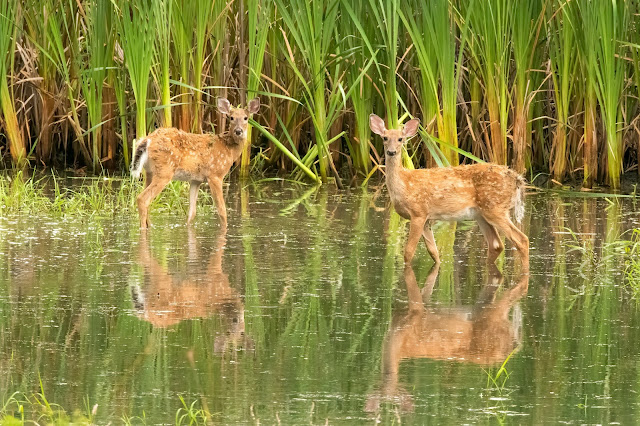Residents, Regulars and Tourists
 |
| Two Young Deer Browse the Wetland, August 21, 2021 |
I happened to catch two young deer -- they still have their spots but were unaccompanied minors -- enjoying a visit to the wetland this morning. It's not uncommon to see deer at the wetland early mornings or in the evenings. Of course they may be coming for water, but I think also they enjoy some of the wetland plants. These two, for example, were acting a lot more like they were at a salad bar than at a drinking fountain.
I have recently been thinking of the creatures at the wetland in terms of residents, regulars and tourists. The residents, of course, are those who completely rely on the wetland for their existence-- at least one or more of their life stages. Recall that fairy shrimp, for example, live and breed in the water, but leave eggs that survive the complete drying out of the wetland in anticipation of its renewal with the winter snows and rains. The many species of dragonflies, damselflies and frogs that breed in the wetland are completely dependent on the wetland for the immature phases of their lives. Some of the frog species also stick around to make their adult living out of the wetland as well, leaving only when the water is gone and presumably commuting over to Homer Lake for the drier and colder parts of the year.
Regulars are like the deer. They stop in on a regular basis, treating the wetland rather like a convenience store. Many of the pollinators, for example, come only when the emergent plants are in flower, though some pollinators actually have an aquatic phase to their lives as well (stay tuned to a future post for more on that). I've only seen the broad-winged hawk perched in a tree overlooking the wetland once this year, but it's possible it comes back periodically when it fancies frog legs for dinner. Racoons and weasels may also easily fall into this category.
Tourists would be the migratory birds and other creatures that pass through and use the wetland like a Motel 6 for a few days. The sora and the blue-winged teals that spent some time in the wetland back in April seem to fit in this category, as do some of the dragonfly species I've seen hanging out a day or two at the wetland before moving on to a habitat more suitable to their particular needs.
I guess the bottom line is that although the wetland is critical habitat to many species, without which they would not survive, it also provides useful services to many other creatures that could almost certainly live without it but benefit from the fact that it is there.



Comments
Post a Comment